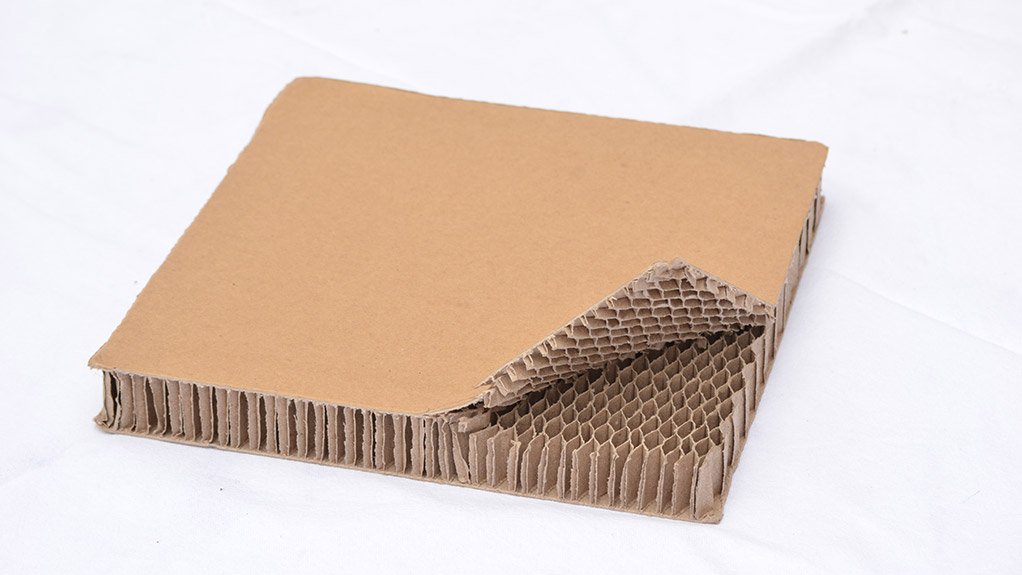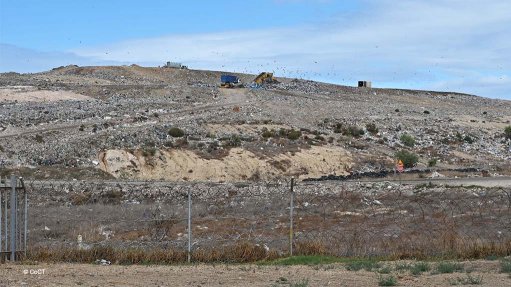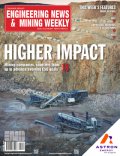Paper Alternative To Wooden Crates And Pallets
This article has been supplied as a media statement and is not written by Creamer Media. It may be available only for a limited time on this website.
A pioneer of paper pallets and paper crates as well as the leading manufacturer of honeycomb fibreboard in South Africa, KIMMO is a transport packaging company that is founded on innovation.
According to Jan Vreken – the founder of Kimmo – he discovered honeycomb fibreboard technology when he started manufacturing corrugated pallets back in 2005 and in 2013 we decided to invest in honeycomb fibreboard technology in order to achieve maximum rigidity in the top decks of our pallets. After a substantial amount of research and proto-typing, we set up a 4500 m2 plant in Johannesburg to manufacture KimmoBoard, an incredibly strong, lightweight fibreboard. Today, all of our pallet decks are made from KimmoBoard and we have extended this functionality to our flagship product range, the KimmoBin – essentially a fibreboard crate that provides a viable and cost effective alternative to wooden crates.”
What is honeycomb fibreboard?
Honeycomb fibreboard technology takes its name from the visual resemblance to a bee’s honeycomb which has an inner cellulose structure that is sandwiched between specially treated paper liners. Honeycomb technology was discovered in the 1950s and is adopted by many other industries due to its unique weight to strength ratio. A honeycomb structure has a minimal weight and high compressive strength - which makes it incredibly strong but surprisingly light.
By adopting this technology, KimmoBoard is ideally suited to the heavy duty bulk packaging industry. It is used to produce a full range of products, such as KimmoPallets, KimmoPalletBoxes and KimmoBins. KimmoBoard offers a compressive strength of 16 tons per m2, ensuring excellent rigidity and protection properties, allowing these products to endure impact and high loads. Its light weight makes Kimmo products easy to transport and move and can provide massive savings with transport costs – particularly for air freight.
No risk of quarantine
Another advantage of KimmoBoard, as opposed to wood, is that it is ISPM-15 compliant. When products are exported in wooden packaging, ISPM-15 requires the wooden packaging to be debarked and then heat treated or fumigated with methyl bromide in order to prevent the risk of pests and insects spreading between countries.
Treating wooden pallets is an expense and can cause complications as heat treating the wood can make it brittle and weak while fumigating wood with methyl bromide is also undesirable. Methyl bromide is a highly toxic, ozone depleting material and cannot be used to treat pallets used to transport food and pharmaceuticals. It is corrosive to the skin and eyes and has an unpleasant mouldy odour.
Recyclability
“KimmoBoard provides outstanding value for its level of strength and rigidity. It is also environmentally friendly (made from recyclable material) and non-toxic. While legislation with regard to recycling is starting to pick up pace in South Africa, there are a number of laws in Europe that already focus on the recycling of packaging. A third party recycler typically disposes to different waste streams. When transporting product using corrugated boxes and wooden pallets, it becomes a headache to separate the wood and paper into two waste streams.
There is a further complication if the wooden pallets have been carrying hazardous products or have been treated with methyl bromide as these products can be absorbed by the wood and provide a huge risk to anyone who uses the wood afterwards. It therefore makes sense to use our products and form one waste stream – saving time, money and the environment,” explains Vreken.
Due to the innovative nature of KimmoBoard and the Kimmo packaging products manufactured from the board, the products are initially met with some scepticism. “The Achilles Heel of KimmoBoard is that people associate it with paper. You cannot compare KimmoBoard to normal cardboard, it is far more comparable in terms of performance and strength to wood. It is like relating Tupperware to GladWrap – they are both made from plastic but are vastly different. But then again, it is an aspect that I enjoy about KimmoBoard – it is often under estimated and takes our customers by surprise in terms of performance and strength. I truly believe that KimmoBoard is an exciting product that has the ability to revolutionize the packaging industry,” adds Vreken.
While Kimmo’s core business resides in packaging, KimmoBoard has other applications like dry walling, sound proofing, ceiling parts, point of sale and furniture. “This provides a myriad of opportunities and can further contribute towards building a thriving local economy and make a difference in the lives of ordinary South Africans. Currently Kimmo is staying true to its culture of innovation by exploring these applications,” concludes Vreken.
Caption (KimmoBoard.jpeg): Honeycomb fibreboard technology takes its name from the visual resemblance to a bee’s honeycomb which has an inner cellulose structure that is sandwiched between specially treated paper liners.
Caption (JanVreken.jpeg> Jan Vreken, founder of Kimmo.
Comments
Press Office
Announcements
What's On
Subscribe to improve your user experience...
Option 1 (equivalent of R125 a month):
Receive a weekly copy of Creamer Media's Engineering News & Mining Weekly magazine
(print copy for those in South Africa and e-magazine for those outside of South Africa)
Receive daily email newsletters
Access to full search results
Access archive of magazine back copies
Access to Projects in Progress
Access to ONE Research Report of your choice in PDF format
Option 2 (equivalent of R375 a month):
All benefits from Option 1
PLUS
Access to Creamer Media's Research Channel Africa for ALL Research Reports, in PDF format, on various industrial and mining sectors
including Electricity; Water; Energy Transition; Hydrogen; Roads, Rail and Ports; Coal; Gold; Platinum; Battery Metals; etc.
Already a subscriber?
Forgotten your password?
Receive weekly copy of Creamer Media's Engineering News & Mining Weekly magazine (print copy for those in South Africa and e-magazine for those outside of South Africa)
➕
Recieve daily email newsletters
➕
Access to full search results
➕
Access archive of magazine back copies
➕
Access to Projects in Progress
➕
Access to ONE Research Report of your choice in PDF format
RESEARCH CHANNEL AFRICA
R4500 (equivalent of R375 a month)
SUBSCRIBEAll benefits from Option 1
➕
Access to Creamer Media's Research Channel Africa for ALL Research Reports on various industrial and mining sectors, in PDF format, including on:
Electricity
➕
Water
➕
Energy Transition
➕
Hydrogen
➕
Roads, Rail and Ports
➕
Coal
➕
Gold
➕
Platinum
➕
Battery Metals
➕
etc.
Receive all benefits from Option 1 or Option 2 delivered to numerous people at your company
➕
Multiple User names and Passwords for simultaneous log-ins
➕
Intranet integration access to all in your organisation























